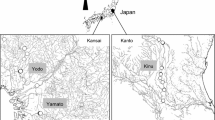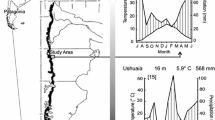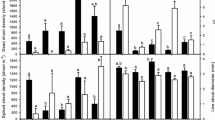Abstract
This study follows the outcome of long-term competition between a broad-leaved and a narrowleaved Typha species, T. latifolia and T. angustifolia respectively, in a eutrophic lake. The lake was bordered by a zone of T. latifolia, at one location interrupted by a T. angustifolia stand. Distributional changes of the T. angustifolia stand and the adjacent zone of T. latifolia were measured on aerial photographs (≤13 years) and along ground-level transects (6 years). A second stand of T. angustifolia was established with transplanted ramets within a formerly homogeneous zone of T. latifolia, and displacement between the two species was measured along ground-level transects after 6 years. Differences between the species in shoot performance were investigated to help explain the relative competitive abilities of the two Typha species. T. angustifolia expanded at the expense of T. latifolia at all water depths where both species occurred, except in very shallow water. Expansion rates suggest that T. angustifolia was not affected by the presence of T. latifolia in water depths exceeding 0.25 m. The Typha species were significantly negatively associated according to rank correlations of shoot densities, and changes of shoot densities, along the transects. These results suggest that T. angustifolia is competitively superior to T. latifolia, contradicting earlier studies. The higher competitive ability of T. angustifolia is consistent with its having taller shoots and a higher standing crop in early summer. Further, shoot height distributions indicated a closer integration of shoot emergence during spring in T. angustifolia than in T. latifolia. A high leaf area/shoot weight ratio suggest that T. latifolia may instead be relatively fast-growing, achieving competitive superiority over narrower-leaved Typha species during a transient period after simultaneous seedling establishment.
Similar content being viewed by others
References
Armstrong J, Armstrong W, Beckett PM (1992) Phragmites australis: Venturi- and humidity-induced pressure flows enhance rhizome aeration and rhizosphere oxidation. New Phytol 120:197–207
Djebrouni M, Huon A (1988) Structure and biomass of a Typha stand revealed by multidimensional analysis. Aquat Bot 30:331–342
Enell M (1982) The phosphorus economy of a hypertrophic seepage lake in Scania, south Sweden — groundwater influence. Hydrobiologia 86:153–158
Fiala K (1978a) Underground organs of Typha angustifolia and Typha latifolia their growth, propagation and production. Acta Sci Nat Brno 12:1–43
Fiala K (1978b) Seasonal development of helophyte polycormones and relationship between underground and aboveground organs. In: Dykyjová D, Kvel J (eds) Pond littoral ecosystems. Springer, Berlin Heidelberg New York, pp 174–181
Fiala K, Kvet J (1971) Dynamic balance between plant species in South Moravian reedwamps. In: Duffey E, Watt AS (eds) The scientific management of animal and plant communities for conservation. Blackwell Scientific Publications, Oxford, pp 241–269
Givnish TJ (1982) On the adaptive significance of leaf height in forest herbs. Am Nat 120:353–381
Grace JB (1985) Juvenile vs. adult competitive abilities in plants: size-dependence in cattails (Typha). Ecology 66:1630–1638
Grace JB (1987) The impact of preemption on the zonation of two Typha species along lakeshores. Ecol Monogr 57:283–303
Grace JB (1988) The effects of nutrient additions on mixtures of Typha latifolia L. and Typha domingensis Pers. along a waterdepth gradient. Aquat Bot 31:83–92
Grace JB (1989) Effects of water depth on Typha latifolia and Typha domingensis. Am J Bot 76:762–768
Grace JB, Wetzel RG (1981a) Effects of size and growth rate on vegetative reproduction in Typha. Oecologia 50:158–161
Grace JB, Wetzel RG (1981b) Habitat partitioning and competitive displacement in cattails (Typha): experimental field studies. Am Nat 118:463–474
Grace JB, Wetzel RG (1982a) Niche differentiation between two rhizomatous plant species: Typha latifolia and Typha angustifolia. Can J Bot 60:46–57
Grace JB, Wetzel RG (1982b) Variations in growth and reproduction within populations of two rhizomatous plant species: Typha latifolia and Typha angustifolia. Oecologia 53:258–263
McDonald ME (1955) Cause and effects of a die-off of emergent vegetation. J Wildl Manage 19:24–35
McNaughton SJ (1966) Ecotype function in the Typha community-type. Ecol Monogr 36:297–325
McNaughton SJ (1975) r-and K-selection in Typha. Am Nat 109:251–261
Poorter H, Lambers H (1991) Is interspecific variation in relative growth rate positively correlated with biomass allocation to leaves? Am Nat 138:1264–1268
Poorter H, Remkes C (1990), Leaf area ratio and net assimilation rate of 24 wild species differing in relative growth rate. Oecologia 83:553–559
Roman T, Roman L, Raduca C, Molnar A (1985) Die Einwirkung einiger Umweltfaktoren des Donaudeltas auf die Abgrenzung des Lebesraumes von Schilf- Rohrkolben-und Seggengesell-schaften. Arch Hydrobiol Suppl 68:149–162
Sale PJM, Wetzel RG (1983) Growth and metabolism of Typha species in relation to cutting treatments. Aquat Bot 15:321–334
Shay JM, Shay CT (1986) Prairie marshes in western Canada, with specific reference to the ecology of five emergent macrophytes. Can J Bot 64:443–454
Tilman D (1988) Plant strategies and the dynamics and structure of plant communities Princeton University Press, Princeton, New Jersey
Tilman D (1990) Constraints and tradeoffs: toward a predictive theory of competition and succession. Oikos 58:3–15
Tilman D (1991) Relative growth rates and plant allocation patterns. Am Nat 138:1269–1275
Weisner SEB (1988) Factors affecting the internal oxygen supply of Phragmites australis (Cav.) Trin. ex Steudel in situ. Aquat Bot 31:329–335
Weisner SEB (1991) Within-lake patterns in depth penetration of emergent vegetation. Freshwater Biol 26:133–142
Yamasaki S, Tange I (1981) Growth responses of Zizania latifolia, Phragmites australis and Miscanthus sacchariflorus to varying inundation. Aquat Bot 10:229–239
Author information
Authors and Affiliations
Rights and permissions
About this article
Cite this article
Weiner, S.E.B. Long-term competitive displacement of Typha latifolia by Typha angustifolia in a eutrophic lake. Oecologia 94, 451–456 (1993). https://doi.org/10.1007/BF00317123
Received:
Accepted:
Issue Date:
DOI: https://doi.org/10.1007/BF00317123




